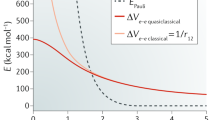Abstract.
The nature of the chemical bonds in the diatomic molecules E 2 (E=N−Bi, F−I), CO and BF has been studied with an energy partitioning analysis using gradient-corrected density functional theory calculations. The results make it possible to estimate quantitatively the strength of covalent and electrostatic attractions and the Pauli repulsion between the atoms. The data suggest that some traditional explanations regarding the strength of the molecules should be modified. The energy partitioning analysis shows that the chemical bonds in the group 15 diatomic molecules have significant electrostatic character, which increases from 30.1% in N2 to 58.3% in Bi2. The contribution of the electrostatic attraction to the binding interactions in Sb2 and Bi2 is larger than the covalent bonding. The strength of the π bonding in the triply bonded dinitrogen is less than that of the σ bonding. The calculations indicate that ΔE π is between 32.2% (Bi2) and 40.0% (P2) of the total orbital interaction energy (ΔE orb). The much stronger bond of N2, as compared with the heavier group 15 E 2 homologues, is not caused by a particularly strong contribution by the π bonding, but rather by the relatively large σ interactions. The comparison of N2 with isoelectronic CO shows that the electrostatic character in the heteroatomic molecule is slightly smaller (28.8%) than in the homoatomic molecule. The contribution of the π bonding in CO is larger (49.2%) than in N2 (34.3%). The reason why CO has a stronger bond than N2 is the significantly weaker Pauli repulsion in CO. The electrostatic character of the bonding in BF is slightly larger (32.0%) than in CO and N2. BF has much weaker π-bonding contributions that provide only 11.2% of the covalent interactions, which is why BF has a much weaker bond than CO and N2. The chemical bonds in the dihalogen molecules have much higher covalent than electrostatic character. The ΔE orb term contributes between 74.4% (Br2) and 79.7% (F2) to the total attractive interactions. The relatively weak bond in F2 comes from the rather large Pauli repulsion.
Similar content being viewed by others
Acknowledgments.
This work was supported by the Deutsche Forschungsgemeinschaft and by the Fonds der Chemischen Industrie. C.E. thanks the Alexander von Humboldt Foundation for a research fellowship. Excellent service by the Hochschulrechenzentrum of the Philipps-Universität Marburg is gratefully acknowledged.
Author information
Authors and Affiliations
Corresponding author
Additional information
Contribution to the Jacopo Tomasi Honorary Issue
A correction to this article is available at http://dx.doi.org/10.1007/s00214-005-0673-9
Rights and permissions
About this article
Cite this article
Esterhuysen, C., Frenking, G. The nature of the chemical bond revisited. An energy partitioning analysis of diatomic molecules E2 (E=N–Bi, F–I), CO and BF. Theor Chem Acc 111, 381–389 (2004). https://doi.org/10.1007/s00214-003-0535-2
Received:
Accepted:
Published:
Issue Date:
DOI: https://doi.org/10.1007/s00214-003-0535-2




